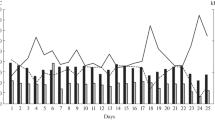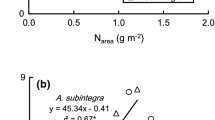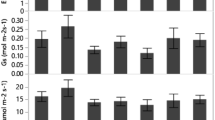Abstract
This study characterized morphological and physiological responses of two Malus species to exogenous abscisic acid (ABA) application under both well-watered and drought-stressed conditions. Exogenous ABA was sprayed onto the leaves of potted 1-year-old seedlings of M. sieversii and M. hupehensis, originated from regions with low annual rainfall and high annual rainfall, respectively. The results demonstrated that exogenous ABA application significantly decreased height growth (H), total biomass (TB), total leaf area (LA), net photosynthesis (A) and stomatal conductance (g s), and significantly increased root/shoot ratio (RS), specific leaf area (SLA), endogenous ABA concentration, water use efficiency (WUE) and carbon isotope composition (δ13C) under both well-watered and drought-stressed conditions. However, distinct interspecific differences were found in ABA-induced morphological and physiological responses. Compared with M. hupehensis, M. sieversii was more responsive to exogenous ABA application, resulting in larger decreases in H, LA, A and g s, and larger increases in RS, SLA, WUEL, WUEi, ABA and δ13C. These results suggest strong evidence for different maintenance of fitness under stressful conditions between species of Malus. In addition, application of exogenous ABA appears to enhance the tolerance of two Malus species to drought-stress.
Similar content being viewed by others
References
Agarwal S, Sairam RK, Srivastava GC, Meena RC (2005) Changes in antioxidant enzymes activity and oxidative stress by abscisic acid and salicy in wheat genotypes. Biol Plant 49:541–550
Alamillo JM, Bartels D (2001) Effects of desiccation on photosynthesis pigments and the ELIP-like dsp 22 protein complexes in the resurrection plant carterostigma plantagineum. Plant Sci 16:1161–1170
Anderson JE, William J, Kriedemann P, Austin MP, Farquhar GD (1996) Correlations between carbon isotope discrimination and climate of native habitats for diverse eucalypt taxa growing in common garden. Aust J Plant Physiol 23:311–320
Bartels D, Sunkar R (2005) Drought and salt tolerance in plants. Crit Rev Plant Sci 24:23–58
Bloch D, Hoffmann CM, Märländer B (2006) Impact of water supply on photosynthesis, water use and carbon isotope discrimination of sugar beet genotypes. Eur J Agron 24:218–225
Cao H, Han Z, Xu X (2002) Effects of water stress on nucleic acid metabolisms and changes of free radicals in Malus. Acta Hortic Sin 29:505–509 (in Chinese with English summary)
Cao H, Han Z, Xu X (2003) Membrane lipid peroxidation damage effect of Chlorophyll in Malus seedlings under water stress. Sci Agric Sin 36:1191–1195 (in Chinese with English summary)
Cao H, Xu X, Han ZH, Wang X, Guo T (2004) Changes of physiological characteristic on photosynthesis in Malus seedling leaves during water stress. Acta Hortic Sin 31:285–290 (in Chinese with English summary)
Chapin FS (1991) Integrated responses of plants to stress: a centralized system of physiological responses. Bioscience 41:29–36
Chapin FS, Autumn K, Pugnaire F (1993) Evolution of suites of traits in response to environmental stress. Am Nat 142:578–592
Chaves MM, Maroco JP, Pereira JS (2003) Understanding plant responses to drought––from genes to the whole plant. Funct Plant Biol 30:239–264
Chen S, Bai Y, Han X (2002) Variation of water-use efficiency of Leymus Chinese and cleistogenes squarrosa in different plant communities in Xilin River Basin, Nei Mongol. Acta Bot Sin 44:1484–1490
Chen G, Shi Q, Lips SH, Sagi M (2003) Comparison of flacca and wild-type tomato grown under conditions diminishing their differences in stomatal control. Plant Sci 164:753–757
Chen S, Bai Y, Lin G, Huang J, Han X (2007) Isotopic carbon composition and related characters of dominant species along an environmental gradient in Inner Mongolia, China. J Arid Env 71:17–28
Cheng L, Fuchigami LH (2000) Rubisco activation state decreases with increasing nitrogen content in apple leaves. J Exp Bot 351:1687–1694
Comstock JP, Ehleringer JR (1992) Correlating genetic variation in carbon isotopic composition with complex climatic gradients. Proc Natl Acad Sci USA 89:7747–7751
Egilla JN, Davies FT, Boutton TW (2005) Drought stress influences leaf water content, photosynthesis, and water-use efficiency of Hibiscus rosasinensis at three potassium concentrations. Photosynthetica 43:135–140
Ehleringer JR, Cooper TA (1988) Correlations between carbon isotope ratio and microhabitat in desert plants. Oecologia 76:562–566
Farquhar GD, Ehleringer J, Hubick KT (1989) Carbon isotope discrimination and photosynthesis. Annu Rev Plant Mol Biol 40:503–537
Gadallah MAA (1996) Abscisic acid, temperature and salinity interactions on growth and some mineral elements in Carthamus plants. Plant Growth Regul 20:225–236
Gibson A, Hubick KT, Bachelard EP (1991) Effects of abscisic acid on morphological and physiological responses to water stress in Eucalyptus camaldulensis seedlings. Aust J Plant Physiol 18:153–163
Golluscio RA, Oesterheld M (2007) Water use efficiency of twenty-five co-existing Patagonian species growing under different soil water availability. Oecologia 154:207–217
Grossnickle SC, Fan S, Russell JH (2005) Variation in gas exchange and water use efficiency patterns among populations of western redcedar. Trees-Struct Funct 19:32–42
Haisel D, Pospíšilová J, Synková H, Synková H, Schnablová R, Baťková (2006) Effects of abscisic acid or benzyladenine on pigment contents, chlorophyll fluorescence, and chloroplast ultrastructure during water stress and after rehydration. Photosynthetica 44:606–614
Handley LL, Nevo E, Ravan JA, Martinez-Carrasco R, Scrimgeor CM, Pakniyat H, Forster BP (1994) Chromosome 4 controls potential water use efficiency (δ 13C) in barley. J Exp Bot 280:1661–1663
Hubick KT, Farquhar JD, Shorter R (1986) Correlation between water use efficiency and carbon isotope discrimination in diverse peanut (Arachis) germplasm. Aust J Physiol 13:803–816
Janet RL, Gawel N (1991) Abscisic acid-induced growth inhibition of sweet potato (Ipomoea batatas L.) in vitro. Plant Cell Tissue Org 24:13–18
Kage H, Kochler M, Stützel H (2004) Root growth and dry matter partitioning of Cauliflower under drought stress conditions: measurement and simulation. Eur J Agron 20:379–394
Kasukabe Y, He L, Nada K, Misawa S, Ihara I, Tachibana S (2004) Overexpression of spermidine synthase enhances tolerance to multiple environmental stresses and up-regulates the expression of various stress-regulated genes in transgenic Arabidopsis thaliana. Plant Cell Physiol 45:712–722
Kozlowski TT, Pallardy SG (2002) Acclimation and adaptive responses of woody plants to environmental stresses. Bot Rev 68:270–334
Leroux D, Stock WD, Bond WJ, Maphanga D (1996) Dry mass allocation, water use efficiency and δ 13C in clones of Eucalyptus grandis, E. grandis × camaldulensis and E. grandis × nitens grown under two irrigation regimes. Tree Physiol 16:497–502
Li C, Wang K (2003) Differences in drought responses of three contrasting Eucalyptus microtheca F. Muell. populations. Forest Ecol Manag 179:377–385
Li C, Berninger F, Koskela J, Sonninen E (2000) Drought responses of Eucalyptus microtheca provenances depend on seasonality of rainfall in their place of origin. Aust J Plant Physiol 27:231–238
Li C, Yin C, Liu S (2004) Different responses of two contrasting Populus davidiana populations to exogenous abscisic acid application. Environ Exp Bot 51:237–246
Marron N, Delay D, Petit JM, Dreyer E, Kahlem G, Delmotte FM, Brignolas F (2002) Physiological traits of two Populus × euramericana clones, Luisa Avanzo and Dorskamp, during a water stress and re-watering cycle. Tree Physiol 22:849–858
Nagel OW, Konings H, Lambers H (1994) Growth rate, plant development and water relations of the ABA-deficient tomato mutant sitiens. Physiol Plant 92:102–108
Nanjo T, Fuita M, Seki M, Kato T, Tabata S, Shinozaki K (2003) Toxicity of free praline revealed in an Arabidopsis T-DNA-tagged mutant deficient in praline dehydrogenase. Plant cell physiol 44:541–548
O’Leary MH (1988) Carbon isotopes in photosynthesis. Bioscience 38:325–336
Osorio J, Osorio ML, Chaves MM, Pereira JS (1998) Water deficits are more important in delaying growth than in changing patterns of carbon allocation in Eucalyptus globules. Tree Physiol 18:363–373
Panek JA, Waring RH (1995) Carbon isotope variation in Douglas-fir foliage: improving the δ 13C climate relationship. Tree Physiol 15:657–663
Pennington RE, Tischler CR, Johnson HB, Polley HW (1999) Genetic variation for carbon isotope composition in honey mesquite (Prosopis glandulosa). Tree Physiol 19:583–589
Sandquist DR, Ehleringer JR (2003) Carbon isotope discrimination differences within and between contrasting populations of Encelia farinosa raised under common-environment conditions. Oecologia 134:463–470
Schroeder JI, Allen GJ, Hugouvieux V, Kwak JM, Waner D (2001) Guard cell signal transduction. Annu Rev Plant Physiol 52:627–658
Schulze ED, Williams RJ, Farquhar GD, Schulze W, Langridge J, Miller JM, Walker BH (1998) Carbon and nitrogen isotope discrimination and nitrogen nutrition of trees along a rainfall gradient in northern Australia. Aust J Plant Physiol 25:413–425
Seki M, Umezawa T, Urano K, Shinozaki L (2007) Regulatory metabolic networks in drought stress responses. Curr Opin Plant Biol 10:296–302
Sharp RE, Poroyko V, Hejlek LG (2004) Root growth maintenance during water deficits: physiology to functional genomics. J Exp Bot 55:2343–2351
Shinozaki K, Yamaguchi-Shinozaki K (2000) Molecular responses to dehydration and low temperature: differences and cross-talk between two stress signaling pathways. Curr Opin Plant Biol 3:217–223
Silim SN, Guy RD, Patterson TB, Livingston NJ (2001) Plasticity in water-use efficiency of Picea sitchensis, P. glauca and their natural hybrids. Oecologia 128:317–325
Steward GR, Turnbull MH, Schmildt S, Erskine PD (1995) A natural abundance in plant communities along a rainfall gradient: a biological integrator of water availability. Aust J Plant Physiol 22:51–55
Sun ZJ, Livingston NJ, Guy RD, Ethier GJ (1996) Stable isotopes as indicators of increased water use efficiency and productivity in white sprace (Picea glauca (Moench) Voss) seedlings. Plant Cell Environ 19:887–894
Tan D (2007) The physiology and biochemistry of programmed Malus sieversii and M. hupehensisi cell death under drought stress. Sci Agric Sin 40:980–986 (in Chinese with English summary)
Tan D, Xu X, Li T, Han Z (2007) The physiology and biochemistry analyzing of programmed cell death under water stress in Malus hupehensis and M. sieversii. Acta Hortic Sin 34:275–278 (in Chinese with English summary)
Trouverie J, Thévenot C, Rocher JP, Sotta B, Prioul JL (2003) The role of abscisic acid in the response of a specific vacuolar invertase to water stress in adult maize leaf. J Exp Bot 54:2177–2186
Wan X, Zwiazek JJ (2001) Root water flow and leaf stomatal conductance in aspen (Populus tremuloides) seedlings treated with abscisic acid. Planta 213:741–747
Wang T, Zhang X, Li C (2007) Growth, abscisic acid content, and carbon isotope composition in wheat cultivars grown under different soil moisture. Biol Plant 51:181–184
Yuan K, Liu Q, Li S, Chen X (2006) A new method for measuring leaf area of fruit trees using digital camera. Acta Hortic Sin 33:829–832 (in Chinese with English summary)
Zhang J, Marshall JD, Jaquish BC (1993) Genetic differentiation in carbon isotope discrimination and gas exchange in Pseudotsuga menziesii. Oecologia 93:80–87
Zhao C, Deng X, Zhang S, Ye Q, Steudle E, Shan L (2004) Advances in the studies on water uptake by plant roots. Acta Bot Sin 46:505–514
Acknowledgments
This work was supported in part by Agriculture Ministry of China and Talent Support Program of Northwest A&F University. The authors would like to thank Dr. Lailiang Cheng for his helps in writing and Mr. Xuanchang Fu for field management.
Author information
Authors and Affiliations
Corresponding author
Rights and permissions
About this article
Cite this article
Ma, X., Ma, F., Mi, Y. et al. Morphological and physiological responses of two contrasting Malus species to exogenous abscisic acid application. Plant Growth Regul 56, 77–87 (2008). https://doi.org/10.1007/s10725-008-9287-2
Received:
Accepted:
Published:
Issue Date:
DOI: https://doi.org/10.1007/s10725-008-9287-2




